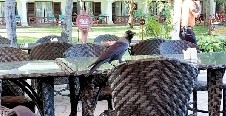Coast hoteliers decry invasive, nuisance birds

More than 100 years ago, black Asian birds – Indian house crow (IHC) – were introduced by foreign workers who were constructing Kenya-Uganda railway.
The birds have since become a threat to food businesses and the hospitality industry in the Coast region.
The Indians who were involved in the building of the metre-gauge railway line introduced the house crow, a common bird of the crow family that is of Asian origin, as part of their culture values into Africa.
Researchers say the house crows were introduced intentionally around 1890 in order to control rubbish. Research indicates that the birds compete with native birds, damage crops and are an urban nuisance.
In recent years the hospitality industry and food businesses in the coast region have struggled with a reduced number of guests and losses following invasion by the IHC.
The birds also grab food from school children during lunch time, disrupt mama mboga businesses, eat young poultry chicks, destroy crops at flowering stage, contribute to noise pollution, taint cars parked under trees and can also disrupt aircraft.
“Mama mboga and small traders selling chips, meat and mandazi face hard times as the birds disrupt their businesses,” Mariam Ngara, a resident of Diani area in South Coast said during an interview with People Daily in Ukunda.
She adds: “The birds excrete on clothes hanging on lines, vehicles parked under trees and their waste is acidic.”
Residents face difficulties when they host events like weddings and dowry ceremonies as the house crows fly over and snatch food from guests.
The birds also snatch food from pets like dogs when they are feeding.
Initially, the Indian house crow was found in Mombasa County but over the years, it has spread to other counties like Taita Taveta, Tana River, Kwale, Lamu, Kilifi and in some sections of Makueni and neighbouring countries of Tanzania and Djibouti.
Near marketplaces and areas with garbage are conducive habitation of the birds foraging for scraps and there are concerns that they may carry pathogens that can cause serious diseases.
The house crows feed largely on refuse around human habitations, small reptiles and mammals.
House crows have also been observed swooping down from the air and snatching baby squirrels. And they roost communally near human habitations and often over busy streets.
Hoteliers
Hoteliers complain that the birds disrupt their businesses, even scaring away guests.
Raymond Matiba, a seasoned hotelier in South Coast, lamented that the IHC is a menace in the region and affects hotel operations and if not controlled will have a huge impact on businesses.
“You cannot even leave a room with doors and windows open as the birds will enter and soil clothes and beddings,” said Matiba of the Safari Beach Hotel during an interview in his hotel recently.
He added: “During breakfast and lunch, the Indian house crows are very active, hence interrupt our customers. They soil tables and even snatch food from guests.”
Matiba observes that presence of garbage in the hotel environs had contributed to the growth of the house crows.
“Over the years, the black Asian birds have increased to about five million and thus suppressed the growth of the population of indigenous birds. The birds are a major hazard to food businesses,” noted Matiba.
He warns that with the growing numbers, the birds could be a serious challenge to food businesses and the hospitality industry in the Coast region in future if not tamed now.
Matiba explains that the house crow challenge has prompted hotel owners and managers to devise ways of controlling them, including hiring guards and gardeners armed with catapults to scare them away, and sometimes changing meal times.
Eradication strategy
The hotel owners also ensure the facilities and the environs are free of garbage which attract crows.
The house crow menace attracted the attention of private sector players in 2016 who introduced a chemical, Starlicide, from New Zealand to deter growth of the birds.
Cecilia Ruto in conjunction with other partners registered Little Kenya Garden Limited (LKGL) to undertake eradication activities of the invasive birds.
Though expensive, the first quantity of the chemical imported last year, managed to kill over 3,000 house crows after being mixed with meat – food which the birds prefer most.
The company creates baiting centres where the birds, after feeding on the baits, die in about eight hours.
“In conjunction with county governments, we will create 12 baiting centres in every county. We have equally presented a financial proposal to the national Government through Kenya Wildlife Service (KWS) and counties seeking support to expedite eradication of the IHC,” said Ruto, a director with LKGL.
Chemical approval
The chemical was temporarily registered in the country last year by the Pest Control Products Board (PCPB) after an efficacy tests were carried out. The landing price of one kilogramme of the chemical currently stands at Sh800,000.
“We had our pre-baiting exercise last year at the Department of Livestock – UKunda veterinary station where thousands of birds died after consuming meat laced with the pesticide,” said Ruto.
Acting general manager in charge of research, strategy and planning with PCPB Paul Ngaruiya confirmed that Starlicide has been temporarily registered and the board will continue to monitor its use and effectiveness.
“PCPB carried out the first efficacy test of the chemical last year and it was effective. This led to temporary registration of the chemical and the company allowed to import it into the country for use to eradicate the indicant house crow,” said Ngaruiya.
The company, he said, will be required to set up pre-baiting centres in all the counties in the region.
“Indian house crows move in big numbers and enjoy human beings habitation. The bird has over the years interfered with local birds, a situation feared will have a huge impact on the environment,” said Ngaruiya.
“These birds have impacted our environment more so by interrupting the population growth of indigenous birds and are noisy in our neighbourhoods,” said Adam Tuller, a resident of Diani of South Coast.










